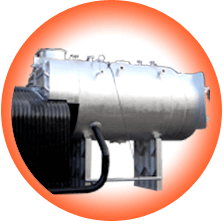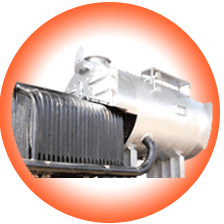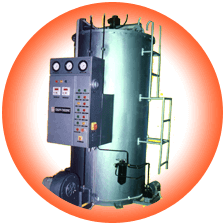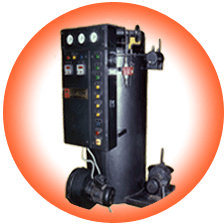CRUPP BOILERS INDIA
Is one of the fastest growing Boiler Manufacturer, with years of experience in Steam Generation, Heater and Burner Technology and a track record of efficient boilers nationwide, providing the full range of Steam Generation with best and efficient Technologies
Our Products

Steam/ Hot-water Boiler
| Vertitherm | Aquatherm | |
|---|---|---|
| Fuel | Oil/ Gas | |
| Capacity | 100 - 800 Kg/hr | 1.0L kCal/hr to 25.0L kCal/hr |
| Pressure | 7 Kg/Cm2 onward | 7 Kg/Cm2 |
| Type | Water Tube (Coil Type) | |

Soild Fuel-Fired Boiler
Fuel : Coal/ Wood/ Briquette/ Bagasse/ Agro Waste
Capacity: Steam: 3000 - 6000 Kg/hr
Pressure: 7 Kg/Cm2 onward
Type: Internal/ Twin Furnace Top Feed (Pet-Coke & Agro Waste)

Meld Series Boiler
Fuel: Coal/ Wood/ Briquette/ Bagasse/ Agro Waste/ Rice Husk/ Pet-Coke
Capacity: 1000 - 10000 Kg/hr
Pressure: 7 Kg/Cm2 onward
Type: External Furnace

Crupp Thermic
Fuel: Oil/ Gas
Capacity: 1.0L kCal/hr to 25.0L kCal/hr
Design: Vertical/ Horizontal
Type: Internal/ Firing (Oil/ Gas)
External Furnace (Solid Fuel)
* Soild fuel based models are also available.

Steam/ Hot-water Boiler
Fuel : Oil/ Gas
Capacity : Steam: 400 - 15000 Kg/hr
Hot-water: 2.0L kCal/hr onward
Pressure : 7 Kg/Cm2 onward
Type : Internal Furnace
Dry Back/ Semi-Wet Back/ Wet Back

Soild Fuel-Fired Boiler
Fuel: Coal/ Wood/ Briquette/ Bagasse/ Agro Waste
Capacity: 400 - 5000 Kg/hr
Pressure: 7 Kg/Cm2 onward
Type: Internal Single Furnace
Dry Back/ Semi-Wet Back/Wet Back
About Our Company
CRUPP BOILERS INDIA
is one of the fastest growing Boiler Manufacturer, with years of experience in Steam Generation, Heater and Burner Technology and a track record of efficient boilers nationwide, providing the full range of Steam Generation with best and efficient Technologies. Our Products include:
➾ Coal, Oil, Gas fired Utility Boilers
➾ Heat Recovery Steam Generators for Power Plants
➾ Steam Boilers (IBR/ Non-IBR)
➾ Hot Water Boilers
➾ Thermic Fluid Heaters
➾ Water Wall Boilers
Customized Boiler Modernization
Our representative will help you select other modernization systems specially suited to your installation. With these, you'll continue to better performance, control load distribution and get better efficiency: Meet code requirements with electronic instrumentation; Save fuel by steam & oil flow monitoring; Efficiency monitoring systems Satisfy load more easily correct piping and valve selections; Improve safety with low-water cutoff and fuel/ Steam pressure switches/ Digital controls; Auto blow down systems; Steam measurement and Totalizers;
Dr. Boiler
How It Works?
Email your queries to drboiler@boilerindia.in and the same shall be posted very soon on this page with a tag no. Experts and other users can reply, put forward their views with the same tag no. in subject line. Their replies will be posted with their names and place details.
Q: Please define turndown ratio and tell what the advantages are for a higher turn down?
A: Turndown ratio is the ratio of maximum fuel input rate to minimum fuel rate of a variable input burner. Traditionally burners on firetube boilers operate in the 4:1 turndown ratio range depending on fuel and size. Advantages of high turndown burners include: Reduction of standby losses Limiting thermal cycling Saves wear and tear of burner components Disadvantages include: Initial cost and complexity Requires more maintenance Limitations of Boiler/burner system The limitations include fuel/air mixing requirements, material temperature issues, flame shape characteristics, flow control limitations and pressure vessel limitations.
Q: What is an IBR Boiler?
A: "Boiler" means any closed vessel exceeding 22.75 litres (five gallons) in capacity which is used expressly for generating steam under pressure and includes any mounting or other fitting attached to such vessel, which is wholly or partly under pressure when steam is shut off.
Boiler Selection
Codes & Regulations
In India Indian Boiler regulations governs the design and safety aspect of boilers and related equipment. Regulatory requirements are dictated by a variety of sources and are all focused primarily on safety. For more information on how the various rules affect boiler selection and operation, kindly contact authorized representative of M/s CRUPP BOILERS (INDIA) PVT LTD. However here are some key points to consider: The boiler industry is tightly regulated by the INDIAN BOILER REGULATIONS (IBR), which govern boiler design, inspection, and quality assurance. The boiler's pressure vessel must be manufactured as per IBR and duly stamped. Most state, local authorities require a permit to install and operate a boiler. Additional restrictions may apply in non-conforming areas where air quality does not meet the requisite ambient air quality standards and emission regulations are more stringent. A full-time boiler operator may be required. Operator requirement depends on the boiler's size, pressure, heating surface or volume of water. Most states require an annual boiler inspection. There may be other requirements on piping as well.
Steam/ Hot Water
The primary purpose of the boiler is to supply energy to the facility's operations - for heat, manufacturing process, laundry, kitchen, etc. Hence we can say boiler falls under the category PROCESS HEATING SYSTEM, where the process may be Dyeing industry, Rubber industry, Milk & food products, Agro based units, Garment exporters, Laundries, Textile units, Hospitals, Hotels, Central Heating units, Pharmaceutical units, Ply Wood Industry, Rice Mills/ Plants, Ordnance Factories etc. The nature of the facility's operation will dictate whether a steam or hot water boiler should be used. Hot water is commonly used in heating applications with the boiler supplying water to the system at 80 Degree Celsius to 100 Degree Celsius. The operating pressure for hot water heating systems usually is 30 psig to 125 psig. Under these conditions, there is a wide range of hot water boiler products can be designed. Steam boilers are designed for low pressure & high pressure applications. Low pressure boilers are limited to 150 psig design, and are typically used for Process heating applications. High pressure boilers are typically used for process loads and can have an operating pressure of 175 to 700 psig. Most steam boiler systems require saturated steam. Steam and hot water boilers are defined according to design pressure and operating pressure. Design pressure is the maximum pressure used in the design of the boiler for the purpose of calculating the minimum permissible thickness or physical characteristics of the pressure vessel parts of the boiler. Typically, the safety valves are set at or below design pressure. Operating pressure is the pressure of the boiler at which it normally operates. The operating pressure usually is maintained at a suitable level below the setting of the pressure relieving valve(s) to prevent their frequent opening during normal operation.
Boiler Load/ Boiler Capacity
System load is measured in Kg./s of steam (at a specific pressure and temperature). Boiler capacity in India is sometimes referred in terms of rating, indicating heat transfer area of the boiler. Determining the total system load requires an understanding of the type(s) of load in the system. A process load pertains to manufacturing operations, where heat from steam or hot water is used in the process. A process load is further defined as either continuous or batch. In a continuous load, the demand is fairly constant - such as in a heating load. The batch load is characterized by short-term demands. The batch load is a key issue when selecting equipment, because a batch-type process load can have a very large instantaneous demand that can be several times larger than the rating of the boiler. For example, based on its size, a heating coil can consume a large amount of steam simply to fill and pressurize the coil. When purchasing a boiler for a process load with instantaneous demand, a more careful boiler selection process should take place. Loads vary and a Boiler plant must be capable of handling the minimum load, the maximum load, and any load variations. Boiler selection is often dictated by the variation in load demand, rather than by the total quantity of steam or hot water required. The seasonal and daily variations define the size of the load that the boiler(s) must handle. Seasonal and daily variations also help define the number of boilers and turn-down requirements. If the instantaneous demand is not included in the system load calculations, the boiler(s) may be undersized. In all cases, operation of the burner should be taken into account in selecting a boiler(s) to meet system demand. The burner will require proper operating controls that can accurately sense the varying demands and be capable of the turndown requirements. The boiler feedwater valve and control design are also critical if load swings are expected.
Number of Boilers
Back-Up Boilers
When selecting the boiler(s), consideration should be given to back-up equipment to accommodate future expansion, emergency repairs, and maintenance. There are a number of considerations for a backup boiler.
Type of Load
Heating systems and non-critical loads that do not result in a sudden loss of production generally have little or no backup. While this is not recommended, it is still common practice. These types of applications rely on the ability to make repairs quickly to reduce downtime. The risk involved in having no backup is a total loss of heat when the boiler is not in service. When process or heating loads use multiple boilers during peak times, and one boiler during most other times, the availability of an additional boiler to provide full backup during maximum demand should be considered. In applications with critical steam or hot water requirements, laws or codes may dictate a backup. Even if laws or codes do not dictate a backup, there are many cases where the operation cannot tolerate downtime. For example, a hotel uses hot water 24 hours a day, seven days a week. During periods of maintenance or in an emergency, a backup boiler is required.
Boiler Turndown
Boiler turndown is the ratio between full boiler output and the boiler output when operating at low fire. Typical boiler turndown is 4:1.The ability of the burner to turn down reduces frequent on and off cycling. Fully modulating burners are typically designed to operate down to 25% of rated capacity.
Performance
Three important considerations pertain to fuels, emissions, and efficiency. All three have important impact on boiler performance, and can affect long-term boiler operating costs.
Fuels Remember, from an operating perspective, fuel costs typically account for major chunk of a facility's total operating budget. Therefore, fuel is an important consideration. Normally, the fuels of choice are natural gas, Agro Waste, Coal, Wood, Brickette, or light oil. Increasingly stringent emission standards have greatly reduced the use of heavy oil and solid fuels such as coal etc. Of the fossil fuels, natural gas burns cleanest and leaves less residue; so does the alternate fuel like Brickette, therefore less maintenance is required.
Emissions Emission standards for boilers have become very stringent in many areas, because of the new clean air regulations. The ability of the boiler to meet emission regulations depends on the type of boiler and burner options.
Efficiency
Efficiency is used in the measure of economic performance of any piece of equipment.
Combustion Efficiency
Combustion efficiency is the effectiveness of the burner only and relates to its ability to completely burn the fuel. The boiler has little bearing on combustion efficiency. A well- designed burner will operate with as little as 15 to 20% excess air, while converting all combustibles in the fuel to thermal energy.
Thermal Efficiency
Thermal efficiency is the effectiveness of the heat transfer in a boiler. It does not take into account boiler radiation and convection losses - for example, from the boiler shell, water column piping, etc.
Boiler Efficiency
The term "boiler efficiency" is often substituted for combustion or thermal efficiency. True boiler efficiency is the measure of fuel-to-steam efficiency. Fuel-to-steam efficiency is the correct definition to use when determining boiler efficiency.
Heating Surface
Heating surface is one criterion used when comparing boilers.
Flue Gas Passes
The number of passes that the flue gas travels before exiting the boiler is also a good criterion when comparing boilers. As the flue gas travels through the boiler it cools and, therefore, changes volume. Multiple pass boilers increase efficiency because the passes are designed to maximize flue gas velocities as the flue gas cools.
Special Considerations
If the boiler is to be placed in an existing facility or new place, there are a number of considerations:
➾ Floor space required.➾ Total space requirements.
➾ Access space for maintenance.
➾ Size and characteristics of the boiler to be replaced including location of existing piping, the boiler stack and utilities.
➾ Boiler weight limitations.
➾ Electric boilers should also be considered, especially since they do not require a stack.
➾ Vertical fire-tube boilers have a small floor space requirement




